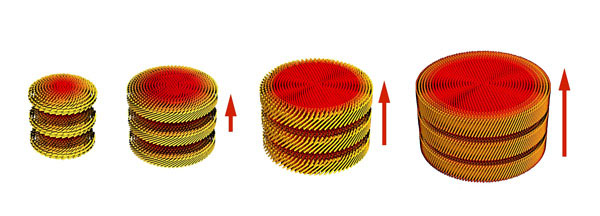| Mar 31, 2025 |
Applying a magnetic field to rod-like viruses induces them to form disks of tunable shape and size.
(Nanowerk News) Seeking to mimic self-assembly processes that occur naturally, RIKEN researchers have demonstrated that the self-assembly of rod-shaped viruses can be controlled by applying a magnetic field (Nature Communications, “Stimuli-responsive self-regulating assembly of chiral colloids for robust size and shape control”). This could help to develop artificial self-assembly processes that are more controllable than existing ones.
|
|
When constructing a house, a bricklayer has to take each brick and cement it in place. But in many biological processes, the ‘bricks’ arrange themselves into structures spontaneously.
|
|
Due to their high efficiency and precision, such self-assembly processes are increasingly being used in areas such as nanotechnology and materials science.
|
|
However, unlike natural self-assembly processes, which terminate once the structure reaches a certain size, artificial ones tend to continue indefinitely. For example, the protein shell of a virus will stop growing when it becomes a sphere or tube of a certain diameter.
|
|
“Because we can’t control the structure size in artificial self-assembly processes, the final size and shape distribution of such structures is very broad,” explains Yasuhiro Ishida of the RIKEN Center for Emergent Matter Science.
|
|
Ishida is keen to discover how nature controls the size in self-assembly processes and then try to replicate it in the lab.
|
|
“Our question is: how can nature control structure size in such highly uncontrollable systems?” says Ishida. “There must be some mechanism that automatically controls the size and shape even under equilibrium conditions.”
|
|
Now, Ishida’s team has used rod-shaped viruses to demonstrate a self-assembly system that produces disks whose diameters can be controlled by a magnetic field. The magnetically induced twisting exploits a property known as chirality that many natural systems use to limit structure size.
|
|
Being chiral, the viruses prefer to pack together with a slight twist between neighbors. When no magnetic field is applied, the disk accumulates a twist during self-assembling, which causes it to stop growing once it reaches a certain diameter (Fig. 1, left).
|
|
Applying a magnetic field to the viruses during self-assembly reduces the amount of twisting between neighboring viruses, which allows the disk to grow larger. Varying the magnetic field intensity alters the disk size accordingly (Fig. 1).
|
 |
| Figure 1: Increasing the size of the magnetic field (red horizontal arrows) applied to rod-like viruses during self-assembly produces thicker, larger disks. Reproduced, with permission, from Ref. 1 © 2015 S. Wang et al.)
|
|
“This process surpasses natural systems in that it can adaptively change the end point of its growth,” says Ishida.
|
|
When the researchers turned off the magnetic field after the disks had formed, the disks began to slowly unravel, producing corkscrew-like structures. “I was so surprised when my students showed me the video of this unravelling,” recalls Ishida. “It was very beautiful to watch.”
|
|
Ultimately, Ishida’s team aims to go beyond nature and develop innovative self-assembly systems. “Our ultimate goal is to use self-assembly to perform things such as small-scale surgeries in the body, for example,” says Ishida.
|


